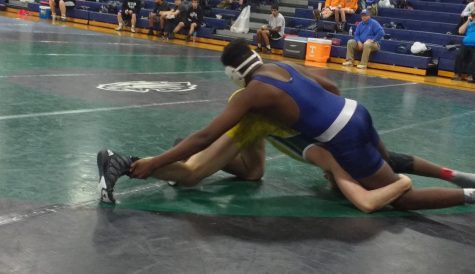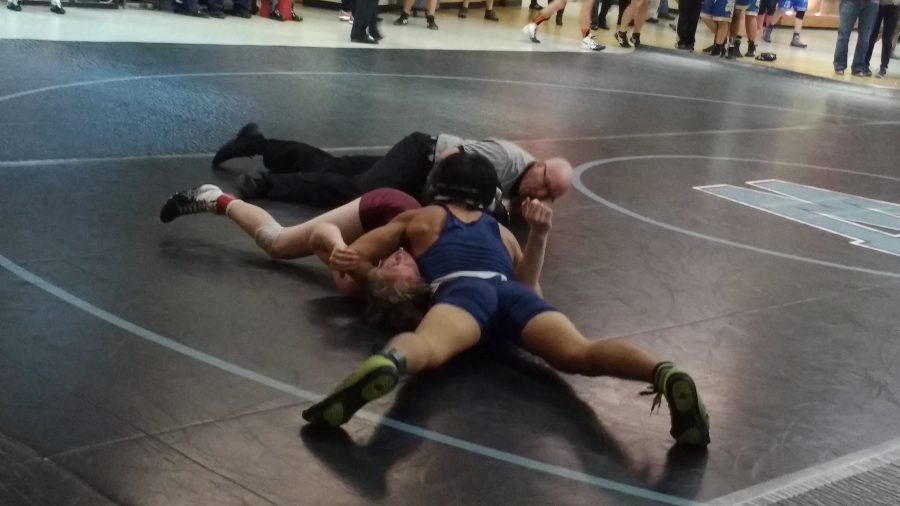Wrestling Team Works to Gain Recognition
LHS wrestler Keven Nguyen (11) secures a pin to win his match at the Ram Rumble. 1/20/17
Virtually everyone at Lafayette knows something about the football, basketball, or soccer team. These three sports host well-attended games, get a good amount of funding, and stand out every year as excellent. The same cannot be said for wrestling. The sport is one of the most overlooked activities at school, but Coach Craig Wortman is determined to put it on the radar.
“We want to build a youth program that funnels directly into the high schools. We’ve got some ideas we’re trying,” says Coach Wortman. “Lots of things have to fall into place for that to happen… James City County needs to change their bylaws in terms of what teams are funded.”
Many members of Lafayette’s team were not introduced to wrestling until their freshman year or later. Aside from WWE, the sport is not widely broadcast or watched on television, and parents worry it is not safe enough for gym class. Wortman thinks otherwise. “People think that it’s really violent. It’s not,” he assures. “It’s not any more dangerous than football or basketball.”
In order to prove themselves worthy of Lafayette’s attention and money, the wrestling team must show that they can win. The preparation for biweekly matches is grueling. Wrestlers often spend 18-20 hours working out per week, and meets can last anywhere from four to twelve hours. They miss time in school setting up for or traveling to matches, so schoolwork tends to pile up. Dieting and weight management are central to the team’s in-season regimen, but Wortman, the self-described “fitness and nutrition guy,” is there to serve as their guide.
“What we’re trying to get them to do is eat small meals six times a day with a balance of carbs and protein,” Wortman summarizes. “We want them to get all junk out of their diet. No candy bars, no sodas, no ice cream, you know, all those kinds of things.”
Wortman also says that the biggest change in the program since he was a high school wrestler is “attention to weight management.” Wrestlers take a test at the beginning of the year to see how much weight they can safely lose, and then try to achieve that weight. “Kids would regularly lose 20, 25, 30 pounds all the time,” he explains. “That’s not allowed anymore… Wrestlers used to do things like getting in saunas with Saran wrap wrapped around them, or go running with five raincoats on, or all different kinds of things just to sweat and sweat and sweat… The rules are designed to protect the athletes.”
“Making weight” is central to the wrestler’s life during the season. Wrestlers are allowed to be anywhere from 106 to 285 pounds, but coaches often require them to reach a certain weight class. In order to compete in the desired weight class, each wrestler must “weigh in” on the morning of a match. If they aren’t within the three-to-five pound window required, they aren’t allowed to wrestle. Junior wrestlers Ben Dallman and Keven Nguyen will be the first to tell you that making weight is no easy task.
Dallman, who has been involved in the program for seven years, says he is “pretty proud” of the time he lost ten pounds in a single day during wrestling season last year. He cites a hard workout, not eating or drinking, and taking long, hot showers to help sweat off weight. He is confident that “everything [he] does is one hundred percent legal in the VHSL rules.” Nguyen, who is likely to compete at the state meet this year, once fasted for four days, rationing half a bottle of water over that span of time. Earlier this year, all he ate for a day was a bag of Dum-Dums. He has set the lock screen on his iPhone to a picture of his goal weight. During the season, he is “much more tired and sluggish in school. It’s harder to pay attention.”

Jay Alex on the mat at the Ram Rumble. 1/20/17
Nguyen blames only himself for his weight management decisions. “The weight loss is one hundred percent the wrestler’s decision,” he says. “A lot of the time it’s not really the coach’s fault… which is why there’s so much drastic weight loss. The weight can be lost with smart planning, but high schoolers are dumb… they want to procrastinate.”
The standardized high school Heath/PE 1 and 2 curricula preach effective methods of losing weight. Teachers warn against “yo-yo dieting,” the habit of losing large amounts of weight in a short period of time only to gain it all back. Neither Nguyen or Dallman have thought twice about health class lessons when losing weight.
“I’ve learned more about how to eat healthy and exercise from wrestling than I have from Health and PE,” says Dallman. “There’s a lot of bad ways to lose weight, but I’ve also learned a lot of really good ways. My body fat percentage has gone down ten percent since freshman year.”
Although the drastic lengths wrestlers go to might be alarming to an outsider, Nguyen and Dallman agree that “the feeling of winning exceeds the pain.”
“I’ll not eat for 48 hours for the feeling you get after you win a match,” says Dallman. “Like, a good match. Not just, like, an easy, roll-over-and-pin match, but a third-period, close, I-fought-for-this match. Absolutely. Because there are no teammates on the mat. It’s just you.”


